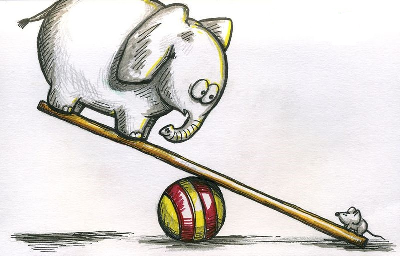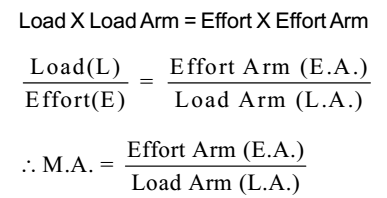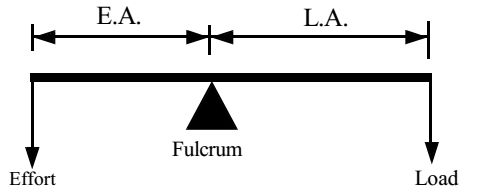Science > Physics > Simple Machines > Levers
A simple machine is a mechanical device that makes our life easier. If a force is applied at one point, the simple machine transmits it to another point with a convenient change of magnitude and direction. In this article we shall study the terminology associated with the simple machines.
Types of Machine:
The basic machines are
- Lever
- Inclined plane
- Pulley (Special case of levers)
- Wheel and axle (Special case of levers)
- Wedge (Special case of the inclined plane)
- Screw (Special case of the inclined plane)
- Gear
In this article, we shall study levers. Levers are the simplest kind of machine used in daily life.

- Lever: A rigid object that is used with an appropriate fulcrum point to multiply the mechanical force that can be applied to another object. A lever is a rigid, straight or bent bar which is capable of turning about a fixed axis. Lever is assumed to be weightless and frictionless.
- Fulcrum: It is an axis about which the lever turns and passes through a point of the lever.
- Effort Arm (E.A.): The distance between the effort and fulcrum is called an effort arm.
- Load Arm (L.A.): The distance between the load and fulcrum is called a load arm.
Principle of Lever:
Lever works on the principle of moments.

This is an expression for mechanical advantage of a lever.
Thus, mechanical advantage of a lever is equal to the ratio of the length of its effort arm to the length of its load arm.
This relation is also known as the law of levers.
- If effort arm = Load arm, then M.A. = 1
- If effort arm > Load arm, then M.A. > 1
- If effort arm < Load arm, then M.A. < 1
Thus, mechanical advantage of lever can be increased by increasing effort arm or decreasing load arm.
Types of Levers:
Depending upon the relative position of the load, the effort and the fulcrum levers have three types: a) Class I levers, b) Class II levers, and c) Class III levers.
Class – I (First Order) Lever:
In this type of levers the fulcrum lies between the load and the effort. It is to be noted that the fulcrum need not be at the midpoint between the load and the effort.

Examples: A see-saw, pliers, scissors, crowbar, Handle of a common water pump, bicycle hand brakes, claw hammer, nodding of human head, etc.


Characteristics of Class – I Lever:
- Fulcrum lies in between load and effort.
- If E.A. > L.A. then M.A. > 1 If E.A. < L.A. then M.A. < 1 If E.A. = L.A. then M.A. = 1
- Generally, this type of lever acts as a force (effort) multiplier.
Notes:
- When effort arm > Load arm, the mechanical advantage and velocity ratio are greater than 1 and the lever acts as a force multiplier. For example, in shears used to cut metal sheets have much longer handles as compared to its blades.
- When effort arm = Load arm, the mechanical advantage and velocity ratio are equal to 1. For example, in physical balance, the effort arm and load arm are equal in lengths.
- When effort arm < Load arm, the mechanical advantage and velocity ratio are less than 1 and it helps in gaining speed. For example, in a pair of scissors blades are longer as compared to its handles.
Why there is a need of long handles for spanners?
Spanner is a class – I lever and we know if effort arm is greater than load arm, then M.A. > 1. When handle is long, small effort can be used to overcome large loads. Thus with longer handle oar, spanners can be used with less effort.
Why does oar used to row a boat has longer handle?
An oar used to row a boat is Class – I lever and we know if effort arm is greater than load arm, then M.A. > 1. When handle is long, small effort can be used to overcome large loads. Thus with longer handle oar, the boat can be rowed with less effort.
Explain why scissors for cutting cloth may have blades longer than the handles, but shears for cutting metals have short blades and long handles.
The cloth is thin, and can be cut very easily but here gain of speed is required, which is obtained by having mechanical advantage less than one. i.e. by making effort arm of smaller than the load arm. Hence scissors for cutting cloth may have blades longer than the handles.
Metal plates require large force to cut them. Hence here force multiplier is required, which is obtained by having mechanical advantage greater than one. i.e. by making effort arm of scissors larger than the load arm. Hence shears for cutting metal may have short blades and long handles.
Class – II (Second Order) Lever:
In this type of levers the Load is lies between the effort and the fulcrum.

Examples:Diving board, door knob, paddle, nut cracker, wheel barrow, bottle opener, oar of a boat. hand flour grinder,



Characteristics of Class – II Lever:
- Load lies in between fulcrum and effort.
- Effort arm is always greater than the load arm, hence the M.A. of class – II lever is always greater than 1. Thus Class II levers always act as force multiplier.
- This type of lever acts as a force (effort) multiplier.
What is a reason that the handle is provided at the rim of a hand flour mill?
A hand flour mill is a class – II lever, and we know that for class – II lever, the effort arm is always greater than the load arm. Hence M.A. > 1. Thus more mechanical advantage can be obtained by increasing effort arm. It can be done by providing the handle at the rim of the hand flour mill. Thus applying small effort, large loads can be overcome.
Class – III (Third Order) Lever:
In this type of levers the effort is applied between the load and the fulcrum.

Examples:Fire tong, boat paddle, Stapler, broom, fishing rod, Ice tong, tweezers, hammer


Characteristics of Class – III Lever:
- Effort lies in between fulcrum and load.
- Effort arm is always less than the load arm, hence the M.A. of class – III lever is always less than 1. Hence it is used for gaining speed. Larger displacement of load is obtained by small displacement of effort.
- This type of lever acts as a speed multiplier.
16 replies on “Simple Machines: Levers”
It’s too helpful 🙂
It helped me a lot to complete my project
Great work.
Very helpful
This work is so good for sure
I love it…It is comprehensive and easy to understand
Thanks for this
This place is good to study
Nice work
Concise and sure
Rich content
It’s really a good place to study
It’s so helpful and understandable
Thank you for this excellent
You guys are the best 😘😘
That are wonderful . And thank you ti your helps
It is a nice way of presentation